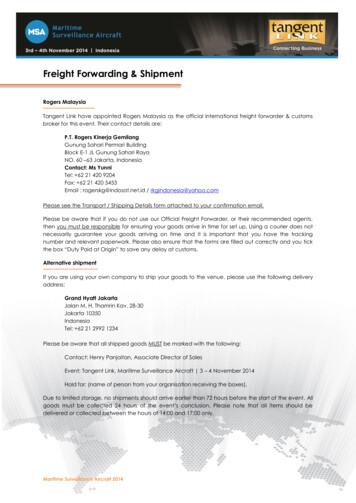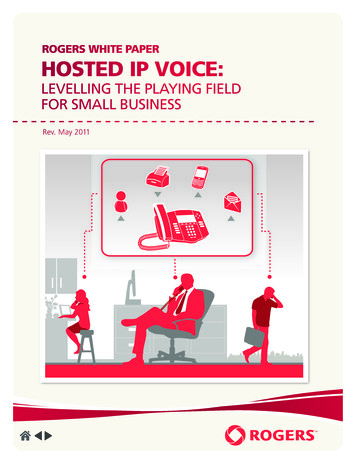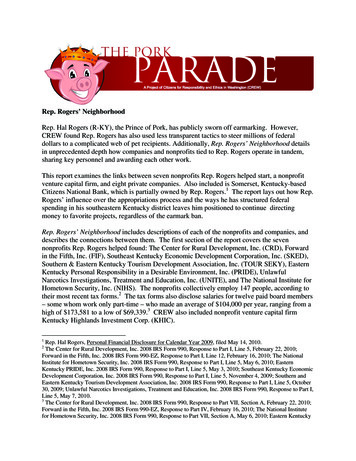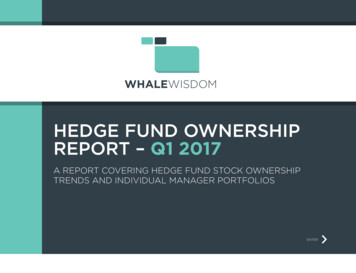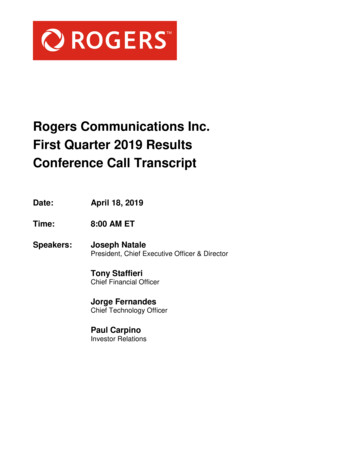
Transcription
Rogers Communications Inc.First Quarter 2019 ResultsConference Call TranscriptDate:April 18, 2019Time:8:00 AM ETSpeakers:Joseph NatalePresident, Chief Executive Officer & DirectorTony StaffieriChief Financial OfficerJorge FernandesChief Technology OfficerPaul CarpinoInvestor Relations
1Operator:Thank you for standing by. This is the conference Operator. Welcome to the Rogers CommunicationsInc. First Quarter 2019 Results Conference Call. As a reminder, all participants are in listen-only mode,and the conference is being recorded. Following the presentation, we will conduct a question-andanswer session. To join the question queue, you may press star then one on your telephone keypad.Should you need assistance during the conference call, you may signal an Operator by pressing starand zero.I would now like to turn the conference over to Paul Carpino with Rogers Communications. Please goahead, Mr. Carpino.Paul Carpino:Thank you, Ariel, and good morning, everyone. Thank you for joining us today. I’m here with ourPresident and Chief Executive Officer, Joe Natale, and our Chief Financial Officer, Tony Staffieri, andJorge Fernandes, our Chief Technology Officer is with us as well.Today’s discussion will include estimates and other forward-looking information from which our actualresults could differ. Please review the cautionary language in today’s earnings report and in our 2018annual report regarding the various factors, assumptions, and risks that could cause our actual resultsto differ.With that, let me begin and turn the call over to Joe.Joseph Natale:Thank you, Paul, and good morning, everyone. Today I’m pleased to share our first quarter results,which highlight continued strong financial momentum and some breakthrough customer metrics. First,let me start with our financials.We delivered strong financial results thanks to disciplined execution by our team. On a consolidatedbasis, excluding certain items for the Toronto Blue Jays, we grew total service revenue by 3% andAdjusted EBITDA by 7%. In wireless, we delivered strong growth in both service revenue and AdjustedEBITDA. We achieved the best postpaid churn in our Company’s history at 0.99%, a key milestone in 2019 Rogers Communications Inc.
2our customer experience journey. Our focus on customer base management and our strategicinvestments in customer experience are driving success in this area.Consistent with our strategy to drive value, we continue to focus on the quality of customer additions.We executed strong pricing discipline to attract high quality customers with the best lifetime value. Thisdiscipline was reflected in bundled ARPU growth of 1%. Overall, it was a quiet first quarter for theindustry, and you will see this reflected in our postpaid net additions.In cable, we delivered solid growth in revenue and Adjusted EBITDA driven by strong growth in internetrevenue. In media, we completed the divestiture of our publishing business, allowing us to focus moresquarely on sports and local programming, the key drivers of our media business. Overall, our Q1results are consistent with our plans to achieve our full year guidance for 201.We completed the repurchase of 155 million worth of shares, our first buyback since 2013. Thisbuyback reflects our underlying confidence in our strategic plan and our long term growth. Between ourshare buyback program and our dividend increase, we will return over 1 billion to shareholders thisyear.As a management team, we remain steadfastly focused on driving growth in our core business anddriving the fundamentals that deliver shareholder value. Execution, discipline, and well-timedinvestments are the key to our success.Last week, we announced the successful outcome of a very important spectrum auction. We acquired52 of the 64 blocks of 600 megahertz spectrum. As the country’s only national network operator, wesecured this key 5G spectrum in every province and every territory. We went into this auction with avery clear disciplined plan. Our auction team did a terrific job of efficiently purchasing this essentialnetwork asset at 1.71 per megahertz per pop. As planned, we are in the process of upgrading ournetwork equipment nationally with new radios, so we’re ready to deploy this spectrum when it isavailable next year.We continue to make great headway on our 5G plan. Through our UBC partnership, we are trialingSmart City applications. Working with Ericsson, we completed our first 5G connection test in downtown 2019 Rogers Communications Inc.
3Toronto on a 5G-enabled network. We are signing national master service agreements with leading realestate partners to deploy small cells, and we are implementing our unified fibre plan to power 5G inmajor city centres. Clearly through our investments, Rogers is ensuring Canadians will continue toenjoy the most advanced networks in the world.In cable, our internet service continues to provide our customers with the best capabilities. We grewinternet penetration for the 15th consecutive quarter. We already offer up to one gigabit speeds to all ofour customers today and our future DOCSIS road map will support upload and download speeds of upto 10 gigabits per second across our entire cable footprint. This broadband connection is the foundationof the home, and our Ignite platform is built on that foundation.We are making steady progress on Ignite TV. The feedback from our customers migrating to our IPTVplatform is very positive. We are seeing impressive results, including significantly improved early lifecycle churn, likelihood to recommend, and average revenue per account. We continue to work withcontent providers to drive additional integration into their platforms, and we have an impressive contentroad map coming up.As I’ve said before, Ignite TV is just the beginning. Ignite TV will deliver a road map that not onlyconnects, monitors, and secures everything in the home, it will enhance the customer experience.Ignite is about managing the whole home ecosystem. Over the long term, we truly have a competitiveadvantage in cable with our world-leading internet and connected home road map. This fully integratedentertainment home automation and security service will ride on and be part of our superior broadbandservice as a whole.In summary, we continue to deliver industry-leading financial metrics while achieving record-breakingpostpaid churn. I’d like to thank our entire team for their incredible dedication and commitment.Tony, over to you.Tony Staffieri:Thank you, Joe, and good morning, everyone. Rogers delivered solid results in Q1, building on thestrong fundamentals we established in 2018. We delivered results that reflected our focus on long-termsustainable growth and our commitment to returning value to our shareholders. 2019 Rogers Communications Inc.
4Starting with our consolidated results, we delivered steady total service revenue growth of 1% and flatAdjusted EBITDA. These year-on-year growth rates were damped by the distribution we received lastyear from Major League Baseball as well as certain baseball-related player transactions in Q1 this year.Excluding these items, total service revenue grew 3% and our Adjusted EBITDA grew 7%.It is worth highlighting as well that commencing with this first quarter of 2019, we start reporting ourfinancials with the adoption of the IFRS-16 lease accounting standard, which is being applied on aprospective basis. This new accounting standard impacts Adjusted EBITDA primarily in wireless andmodestly in our other business units but does not impact the underlying economics of our business. Ona consolidated basis, this change improved the Adjusted EBITDA growth rate by three points.In wireless, we reported strong service revenue growth of 4% this quarter. With a keen focus onrevenue market share, we delivered a combination of 23,000 postpaid net subscriber additions alongwith growth of 1% in blended ARPU and 3% in blended ABPU. As noted by Joe, our improvements incustomer experience and base management were very strong and drove churn down to an all-time bestof 0.99% this quarter. Clearly, there’s significant economic benefit to our business by focusing onimproving churn, and this will remain a top priority within the Company.On the subscriber front, although down from last year, we were pleased with our subscriber gross andnet adds in the quarter given the industry dynamics, the disciplined market approach we took, and ourexceptional churn results. Even in this quieter environment, we’re confident we performed well in termsof share of revenue growth this quarter.In comparing subscriber activity to the prior year, it’s important to note that Q4 of 2017 had quite a bit ofheightened promotional activity which spilled into Q1 last year. This wasn’t the case this year, and infact, promotional intensity was amongst the lowest we have ever seen in a first quarter. Nonetheless,we remain confident in robust subscriber growth for us and the industry for the remainder of the year.On wireless Adjusted EBITDA, we reported growth of 9%, which reflected healthy flow-through of ourstrong service revenue growth as well as the impact of the new lease accounting standard.Turning to cable, we grew revenue by 1% this quarter and Adjusted EBITDA by 3%. Our internetproduct continues to be the driver of growth in our cable business. Internet revenue grew 7% thisquarter, reflecting continued monetization of the increasing demand for data and higher speed tiers. We 2019 Rogers Communications Inc.
5remain uniquely positioned to meet customer demand for faster speeds and higher data with our abilityto offer Ignite gigabit internet across our entire cable footprint.We reported 14,000 net subscriber additions, down 12,000 from last year but still reflecting continuedgrowth in our internet penetration rates. As well, we were pleased to see internet ARPU growthaccelerate from the previous quarter. On Adjusted EBITDA, despite incremental costs related to thelaunch of Ignite TV, we expanded cable margins this quarter due to continued focus on efficiencies andproduct mix shift to higher margin internet.Moving to media, this quarter’s revenue and EBITDA were lower, driven by distribution for MajorLeague Baseball in 2018 and certain baseball-related player transactions occurring in the first quarterof this year. Excluding these items, media revenue would have been flat, and our Adjusted EBITDAwould have decreased by 25%. This decline year-on-year was solely due to timing differences in thequarter related to rights fees expense relative to the broadcast revenues. We continue to operate thebest media and sports assets in our industry with increasing efficiency, and you’ll see that in the fullyear margin improvement for media.Turning back to some consolidated highlights, we invested 617 million in CapEx for the quarter, whichincreased 2% year-over-year. In wireless, we continue to invest in 4.5G as we ready our networks fornext generation 5G capabilities. In cable, we continue to roll out Ignite TV as well as pull forward nodesegmentation to recognize economies of scale and ensure that our hybrid fibre-coax network continuesto be well ahead of consumer demand.With respect to cash flow and returning capital to shareholders, we generated free cash flow of 405million this quarter, a decrease of 8% year-over-year primarily as a result of the timing of higher cashincome taxes in the quarter partially offset by lower interest on borrowings. During the quarter, wereturned dividends of 247 million and also bought back 155 million in Class B non-voting shares aspart of our NCIB program.We ended the quarter with a debt leverage ratio of 2.7 times, which is flat to a year ago despite thelease accounting change, which added 0.2 of leverage to this year’s reported number, so a healthyimprovement year-on-year in substance. 2019 Rogers Communications Inc.
6As you saw in our release this morning, we entered into a 2.2 billion non-revolving credit facilitysubsequent to the quarter end. This additional financial capacity gives us ample liquidity to fund ourrecently secure 600 megahertz spectrum. We had liquidity of 1.9 billion at the end of the quarter andhave solid investment-grade credit ratings with stable outlooks. Additionally, our balance sheet is wellpositioned with long-term maturities and low interest rates on our outstanding debt. Our weightedaverage cost of borrowings was 4.43% as at March 31, 2019, and our weighted average term tomaturity was 10.5 years.We’ve had a strong start towards delivering on our guidance this year and remain focused on drivingprofitable growth in the business, investing in the future, and returning value to our shareholders.With that, I’ll ask the Operator to open the lines for questions.Operator:Thank you. We will now begin the question-and-answer session. To join the question queue, you maypress star then one on your telephone keypad. You will hear a tone acknowledging your request. If youare using a speakerphone, please pick up your handset before pressing any keys. To withdraw yourquestion, please press star then two.Our first question comes from Jeffrey Fan of Scotiabank.Jeffrey Fan:Thanks and good morning. Let’s start with the state of the wireless industry a little bit, and particularlyon ARPU and ABPU. I know your ABPU held up this quarter, nice growth at 3%, but I guess the gapversus ARPU is starting to widen. The ARPU growth slowed a little bit from last quarter. I’m wonderingif you can talk a little bit about the dynamics around that, and which do you think the market shouldfocus on with respect to how to understand the underlying economics.Then just a clarification on your guidance, 7% to 9% EBITDA growth for the year, does that includethese baseball transactions, or does it exclude the baseball transactions that you alluded to? Thanks.Joseph Natale: 2019 Rogers Communications Inc.
7Thanks for the question, Jeff. Let me start with the ARPU versus ABPU question. I think in response toyour question, we look at both of them, but clearly ARPU is the more significant underlying metric whichwe think is important. It really gets at the true service revenue per customer, excluding the handsetsubsidy that’s embedded in the monthly rate, so that really is fundamental to the economics, so that’sthe one we focus on. The ABPU metric is important relative to the COA and COR that we spend.In terms of the widening gap between the two, I think what you’re seeing is more subsidy embedded inthe ABPU numbers. You may recall in the latter half of 2018, we and the industry moved to anadditional 200 subsidy on certain high-end plans, and so what you’re seeing is more of that embeddedin the ABPU number, so that’s the primary difference between ARPU and ABPU. Again, it’s the amountof subsidy that’s embedded in the monthly service fee.On your second question related to guidance, the guidance we provided is inclusive of all of ouroperations, and so it included the baseball operations as well for the full year.Jeffrey Fan:Okay, thank you.Paul Carpino:Thanks, Jeff. Next question, Ariel.Operator:Our next question comes from Tim Casey of BMO.Tim Casey:Thanks. Just wanted to follow up on Jeff’s question on the state of the wireless market. Can you talk alittle bit about or reflect more on your comments that you said it was a very slow quarter across theboard? I think you mentioned it’s the slowest you’ve seen in a while. I get the fact that the comps aredifferent because of the spillover from Q1 ’17 into ’18, but maybe just a little bit more about what you’veseen out there in the market, and what your expectations are for the rest of the year. Thanks. 2019 Rogers Communications Inc.
8Joseph Natale:Sure, Tim. Happy to talk about that. As Tony mentioned, it was a quiet Q1, and Q1 is often very quiet,but promotionally so. For the first two thirds of the quarter, it was very quiet, and mind you, we didn’t doanything overly aggressive to excite or stimulate the market from that perspective. We saw things startto ramp up again near the last couple of weeks of the quarter, and we saw volume start to kind of growoverall at that point.Looking forward, we continue to see robust growth opportunity. It may not be as high as Q4. Q4 hadsort of a 5.7% growth factor, but still very healthy growth overall. The market usually gets stimulated bya couple of factors, either the availability and focus on some iconic handsets that people findcompelling and want to get up to go take a look at, we really didn’t have that factor playing for us asheavily this time around, and then price stimulation with respect to data promotions, and again thatdidn’t happen until very late in the quarter.We took every opportunity to kind of focus on price discipline and focus on lifetime value. We talkedabout ARPU and ABPU a few minutes ago. Lifetime value for us is up 10% this quarter because of thecombination of ARPU, ABPU and then the overall churn improvement as a whole, and those are theunderlying fundamentals that are there coupled with the fact that we believe there’s still strong growthopportunity in the marketplace. Penetration is still moving from 87% to 120% as a whole. Immigration isstill running at about 2%, so those fundamentals have been changed, it’s just the typical Q1 start to theyear, largely predicated by how intensive and how busy was the Q4 period and the Christmas periodleading into it.Tim Casey:Thank you.Paul Carpino:Thanks, Tim. Next question, Ariel.Operator:Our next question comes from Dave Barden of Bank of America Merrill Lynch. 2019 Rogers Communications Inc.
9Matt Griffiths:Hi, it’s Matt Griffiths sitting in for Dave. Thanks for taking the question. I just wanted to ask again onwireless. I just wanted to get your thoughts on how much of the low churn that you reported this quartermay have been influenced by just that general market quietness and slowness that you referred to, andmaybe how much was accounted for by the initiatives that you’ve had underway for some time now.Joseph Natale:Matt, I would say that the vast majority of the reasons for the lower churn have to do with the basemanagement activities that we’ve been working on as a Company for the last couple of years, and thatis taking a look at all the reasons why customers would consider–because they’re leaving us, andworking hard to overcome some of those challenges, whether it’s end of a promotion, a handsetupgrade, a particular service issue, whatever that might be. The team has worked extraordinarily hardto really improve the customer experience journey and therefore drive a much better churnimprovement, and you can see that quarter-on-quarter for the last many in terms of the types of churnimprovements, whether they have come in busy times or quiet times, we’ve been consistent indelivering on the churn improvement.Matt Griffiths:All right, thanks. One more, if I may, on the cable side. There’s a slowdown in the internet or broadbandnet adds, and I was just wondering if this was a slow quarter comparatively year-over-year on that frontas well, or if you would expect that to pick up.Joseph Natale:Yes, I’d say a couple things. First of all, housing starts in Canada were running at about 2%. I thinkyou’ve seen the results out there, they’re more like 1% in Q1, so it was a little bit of dampening on thehousing starts front. Having said that, we’re still very happy with the fact that we continue to growinternet penetration, and that penetration for us went up 1.6% overall to 55.8%, and that’s manyquarters now strong in a row in terms of growth in internet penetration. We’re pleased with the fact thatwe continue to grow the portfolio.There will be seasonal periods as well within the internet business, largely centred around moveperiods through the summer, back to school, students connecting and disconnecting. It is one of thequieter quarters, but we’re pleased with the continued growth and momentum in penetration. 2019 Rogers Communications Inc.
10Matt Griffiths:All right, thank you.Paul Carpino:Thanks, Matt. Next question, Ariel.Operator:Our next question comes from Simon Flannery of Morgan Stanley.Simon Flannery:Great, thanks. Good morning. Just coming back to the 600 megahertz purchase in the auction, couldyou just talk about what the plan is, the timeline for building that out over the next few years, and thenrelated to that, obviously it adds some leverage. You talked about the credit facility, but you’re alsobuying back stock, so just help us think about the shape of the leverage, and what you want to get thatback to, and how you’re going to balance deleveraging versus future buybacks. Thanks.Joseph Natale:Sure. Thanks, Simon. Let me make a few comments, and then I’m going to ask Jorge Fernandes, ourCTO who is here with us today, to talk specifically about 600, its value to us, and the deploymentapproach to it, and then we’ll circle around with respect to the capital allocation question.First of all, we’re very pleased with the outcome of the 600 megahertz auction. We walked into theauction with a very clear strategy and a plan. We won spectrum coast to coast, as you know, Simon, 20megahertz nationally and then 40 megahertz in some very specific regions, southern Ontario being themost critical and which is almost half of Canada’s population, where we got four blocks. We paid a priceconsistent with precedent auctions overall and just generally the valuation of spectrum in Canada as awhole. These are 20-year licenses with renewal, so very excited about this.Bear in mind that in the history of wireless, there have only been three low frequency spectrumauctions, and we’ve participated in all three and done well in all three. Jorge will talk to the importanceof it. We don’t see there being another low frequency spectrum auction in the foreseeable future, so thisis a generational opportunity for us to make the right investments for 5G and beyond, for that matter. 2019 Rogers Communications Inc.
11Jorge, you want to talk a bit about our plans and your thoughts just overall about the importance of thespectrum?Jorge Fernandes:Sure, thank you, Joe. Good morning, Simon. For us, the 600 spectrum is incredibly important, andwe’re very happy to have acquired as much as we did, frankly. As you know, low band spectrum isfoundational for any network. Low band gets in everywhere in urban areas and over long distances inrural areas, and we have seen that low band does, in fact, make a difference between a great networkand an average network, especially in providing consistent quality across the board. Obviously, if wethink about Canada and if ever there was a country that benefits and justifies such spectrum, of courseit’s Canada with our very low population density.As Joe mentioned in the beginning, we’re modernizing our infrastructure as we speak, and so we willbe able to get 600 out there very quickly off the mark as soon as 5G gets into place and the handsetsbecome available, so we will be able to very quickly provide a wide area coverage of 5G without a hugecost. Frankly, as new use cases are developed for 5G, low band will work in tandem with the mid bandand high band spectrum that will become available over time to provide this contiguous layer of nationalcoverage and then using the mid band and the high band capacity where we need for both 4G and 5G.Tony Staffieri:Then finally, Simon, on your question with respect to leverage, I think even after the auction, we sit in apretty comfortable place with respect to our leverage. The report at quarter end was 2.7 times, but as Isaid, 0.2 of that is really due to the change in lease accounting standards, so in substance we sit at 2.5on a like-for-like basis relative to previous numbers you would have seen. We continue to reduce thatyear-on-year at a healthy clip of about 0.2. The spectrum acquisition will add 0.2, so on a like-for-likebasis it puts us at about 2.7, so again very comfortable within–we’ve talked about ranges in 2 to 2.5,and that was based on previous accounting standards, so when you put all that together, we’re sort ofwithin or very close to the target ranges we’ve had.In terms of what does that mean for share buybacks, we’ve said we’ve committed to returning of cashto shareholders, and what you saw in the first quarter is a combination of us putting our cash to use thatway as well as being opportunistic with some of the–relative to some of the long term values that wesee for our business. That will be something that I think we have room to be balanced about goingforward, although I would caution that you may not see the levels of buybacks that you saw in Q1. We’ll 2019 Rogers Communications Inc.
12continue to be prudent about the timing and how much, but expect it to be well-balanced, but again,overall the leverage ratio sitting at a very good spot.Simon Flannery:Great, thanks for the colour.Paul Carpino:Thanks, Simon. Next question, Ariel.Operator:Our next question comes from Drew McReynolds of RBC.Drew McReynolds:Thanks very much. Thanks for taking my questions. Two, I guess, bigger pictures ones, maybe for you,Joe. On the balance between profitability and subscriber growth, clearly this quarter and emphasislooks a little bit more on profitability, but just wondering, as the industry overall evolves, is there anychange here between how Rogers sees that balance? Then second question on the seasonality ofwireless loading across the industry, do you get a sense just based on what we saw with Q1 that thatseasonality is shifting or continues to shift a little bit more to the back end of the year, or was Q1 reallyan aberration in the grand scheme of things? Thank you.Joseph Natale:Good questions. Thanks, Drew. I’d say overall, the balance of subscriber additions and profitability isone that we look at on a regular basis. I think you’ve heard me say before on this call that we’re notgoing after loading for loading’s sake. There is a lot of bad loading out there if you want it. We’re reallyfocused on adding customers that–and the types of propositions that make sense economically as awhole and are accretive economically, so it’s not kind of one or the other. I think it’s really kind offiguring out where is that striking balance with respect to the economics as a whole.I would say to you that it’s a question of really being well-timed. Every quarter is a bit different from thatperspective.To your secondary question, there is a seasonality more than ever in the wireless business. In a lot ofways, we’ve trained the market to focus on key selling periods, and then the hardware or handset 2019 Rogers Communications Inc.
13manufacturers have kind of aligned themselves to those key selling periods, so we’ve created thesemoments in time where there is froth and opportunity in the marketplace, there is retail traffic. Certainly,the busiest period of all, I would say starts with Black Friday and works its way through the holidayseason and Boxing Week. I would say the next busy season is back to school as sort of a key period oftime, and then there are some other sort of smaller periods out there in the marketplace.The market is very promotionally efficient; I guess is one way of describing it. The market is very muchfocused on looking where is there a promotional opportunity, and when is the right time to kind of weighin and look at changing providers, look at upgrading handsets, etc. I think it’s prudent for us as leadersto kind of figure out where is that well-timed balance. We can very easily drive and stimulate the marketat any particular point in time, but that comes at an economic price, and at the end of the day, we’retrying to drive long-term shareholder value, and that’s really underpinned in metrics like continuedgrowth in ARPU. It’s underpinned by churn results and therefore lifetime value, it’s underpinned inmargin expansion, and so we will weigh that off against growth in customer additions in the right time inthe marketplace, and kind of save our powder for those times of the year when we really can make adifference and there are great customer adds to be had.Is that helpful, Drew?Drew McReynolds:Yes, that is. Maybe a quick follow-up just for you, Tony. You just talked about the IFRS-16 impact,which you’ve said before is primarily in wireless. We can take this offline, but just wondering what theactual impact would have been in cable and media, so however you want to quantify that, that’d behelpful as well. Thank you.Tony Staffieri:Sure. As you said, we can take it offline, but a couple of things could be helpful that I think really get atwhat you’re asking. In terms of the total impact, I talked about that at a consolidated level. If you wereto look at the wireless results in terms of EBITDA growth, IFRS impact was about half of that growth,and then for cable and media, it’s almost nothing in terms of growth rates.Drew McReynolds:Great. Thank you. 2019 Rogers Communications Inc.
14Joseph Natale:I thought you were going to do a full lesson on IFRS-16. I was looking forward to it.Tony Staffieri:It would have been my moment.Paul Carpino:Thanks, Drew. Next question, Ariel.Operator:Our next question comes from Aravinda Galappatthige of Canaccord.Aravinda Galappatthige:Good morning. Thanks for taking my questions. Just a quick follow-up to start with on the cablesubscriber trends. I know you talked to some of the lower household formations, but I was wonderingthe extent to which competitive actions had an impact as well, in particular, was wholesale a factor?Were the resellers more active as well as, obviously, the fibre rollout of the competitor? I just wanted toget a sense of the activity and the promotions that would have had an impact potentially.Secondly, with respect to cost reductions, I know that IFRS-16 sort of impacts a direct comparison ofthe OpEx, but I wanted to get a sense of how you see–you’ve obviously
Rogers Communications Inc. First Quarter 2019 Results Conference Call Transcript Date: April 18, 2019 . major city centres. Clearly through our investments, Rogers is ensuring Canadians will continue to . remain uniquely positioned to meet customer demand for faster speeds and higher data with our ability



